In the vast expanses of wetlands and grasslands, a majestic traveler graces the skies with its presence – the Greater White-Fronted Goose (Anser albifrons).
With its distinctive markings and seasonal migrations, this elegant bird captures the imagination of birdwatchers and nature enthusiasts alike.
From the Arctic tundra to temperate and subtropical regions, the Greater White-Fronted Goose embarks on epic journeys, symbolizing resilience and adaptability in changing landscapes.
Join us on a journey into the world of the Greater White-Fronted Goose as we uncover its fascinating biology, behavior, and ecological significance.
From its nomadic lifestyle to its intricate social dynamics, this iconic waterfowl species offers a window into the interconnectedness of ecosystems across continents.
Prepare to be enthralled by the grace and grandeur of the Greater White-Fronted Goose as we delve into its captivating world. Read on!
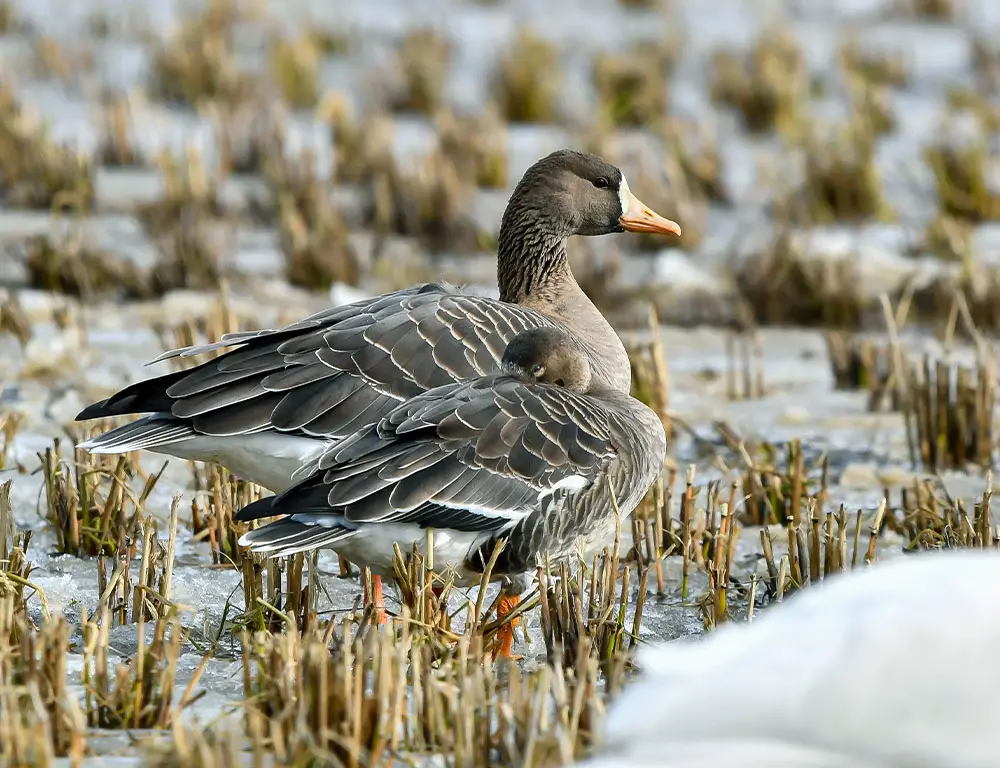
Describing the Key Physical Characteristics of the Greater White-Fronted Goose
The Greater White-Fronted Goose is a medium-sized waterfowl species with distinctive physical characteristics that set it apart from other geese. Here are the key physical characteristics of the Greater White-Fronted Goose:
Size
Greater White-Fronted Geese are medium-sized birds, with adults typically measuring between 64 to 81 centimeters (25 to 32 inches) in length and weighing around 2.3 to 3.6 kilograms (5 to 8 pounds). Their wingspan ranges from 130 to 165 centimeters (51 to 65 inches).
Plumage
The plumage of the Greater White-Fronted Goose varies depending on age, sex, and geographic location. Adult birds have a predominantly grayish-brown body with darker barring or mottling on the back and wings.
The breast and belly are typically lighter in color, ranging from white to buff. One of the most distinguishing features of the species is the white patch or “front” on the face, which extends from the bill to the base of the throat.
Bill
Greater White-Fronted Geese have relatively short and stout bills compared to other goose species. Their bills are typically pinkish or orange with a darker tip and base. The bill is adapted for grazing on vegetation and probing for food in shallow water.
Legs and Feet
The legs and feet of Greater White-Fronted Geese are relatively short and stout, suited for walking and swimming in shallow water. Their feet are webbed, facilitating propulsion through the water while foraging for food.
Neck and Head
The neck of the Greater White-Fronted Goose is medium-length, with a slight S-shaped curve. The head is small and rounded, with a short, stubby bill and a prominent forehead.
Adult birds have a distinctive white patch on the face, extending from the bill to the base of the throat, which gives them their name.
Wing Shape
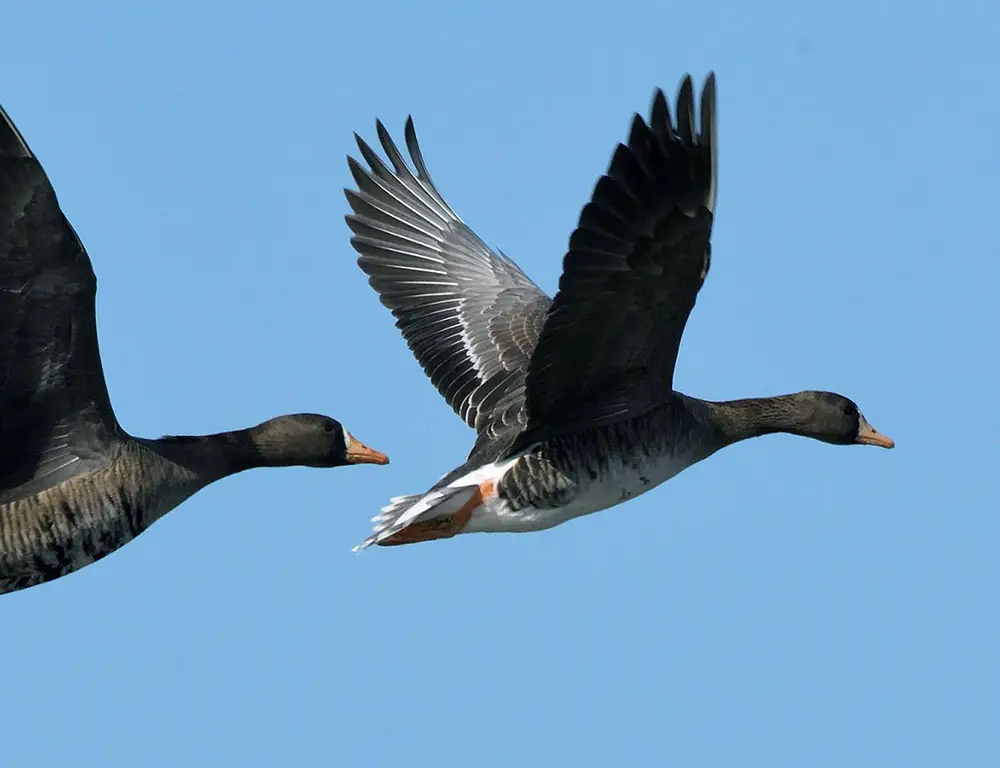
Greater White-Fronted Geese have broad and rounded wings, which enable them to perform robust and sustained flights during migration. Their wings produce a distinctive whistling sound in flight, especially during the rapid beats of their wingtips.
Sexual Dimorphism
Sexual dimorphism in Greater White-Fronted Geese is minimal, with males and females generally exhibiting similar plumage and physical characteristics. However, males may be slightly larger and heavier than females on average.
Vocalizations
Greater White-Fronted Geese are known for their distinctive calls, which vary depending on the situation. During migration and in flight, they produce a loud, honking call that can be heard over long distances.
While on the ground or during feeding, they may emit softer clucking or chattering sounds to communicate with other flock members.
Breeding and Food Habits of the Greater White-Fronted Goose
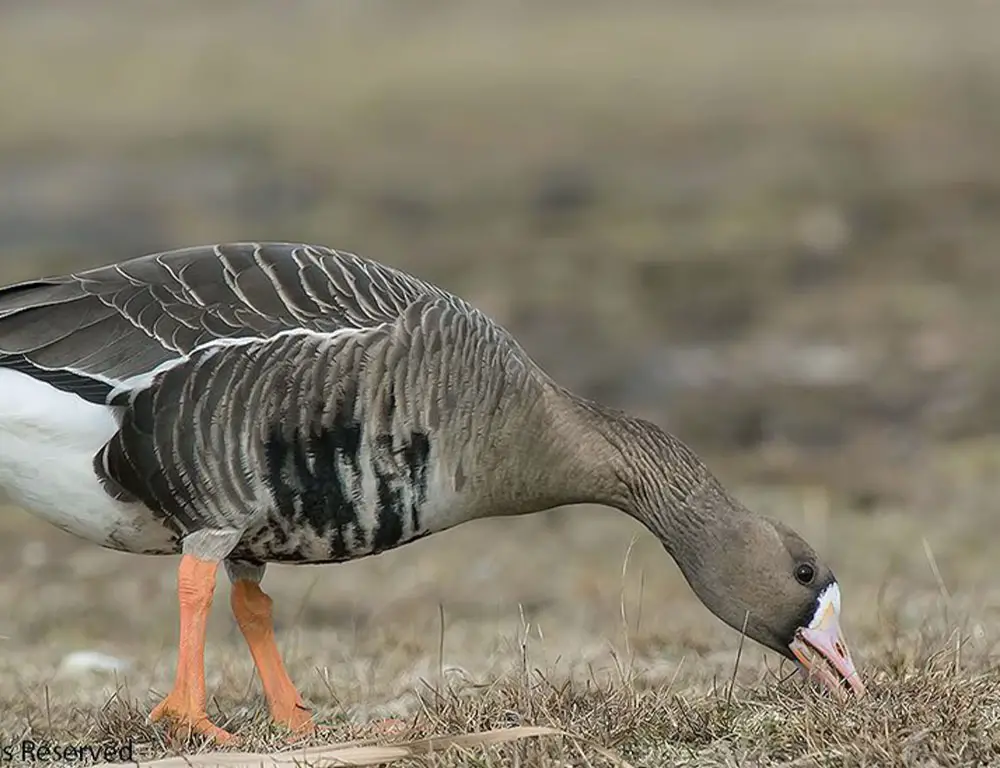
Discover the fascinating breeding behaviors and dietary preferences of the Greater White-Fronted Goose, shedding light on its role in the ecosystem and conservation efforts.
Taxonomy
| Taxonomy Level | Classification |
| Kingdom | Animalia |
| Phylum | Chordata |
| Class | Aves |
| Order | Anseriformes |
| Family | Anatidae |
| Genus | Anser |
| Species | Anser albifrons |
Food Habitat
Greater White-Fronted Geese are highly adaptable birds that inhabit various wetland and grassland habitats throughout their range.
They primarily feed on plant matter, including grasses, sedges, and crops such as grains and tubers. During the breeding season, they may also consume insects and small invertebrates to supplement their diet.
Nesting
| Nest Location | Description |
| Nest Site Selection | Both males and females participate in nest construction, combining plant materials and down feathers to create a shallow depression lined with soft materials. |
| Nest Construction | Breeding season varies depending on geographic location, with nesting typically occurring in the spring and early summer. |
| Nesting Season | Breeding season varies depending on geographic location, with nesting typically occurring in the spring and early summer months. |
| Clutch Size | Clutch sizes range from 4 to 6 eggs, with the female responsible for incubating the eggs while the male stands guard nearby. |
| Incubation Period | Incubation lasts approximately 22 to 28 days, during which the female remains dedicated to keeping the eggs warm and protected. |
| Fledging and Growth | Chicks hatch precocial, with their eyes open and covered in down feathers. They remain in the nest for a few days before venturing out with their parents to forage. |
Breeding
Breeding behaviors of Greater White-Fronted Geese are characterized by monogamous pair bonds formed during the wintering season.
Breeding pairs return to their breeding grounds in the spring, engaging in courtship displays and territorial behaviors.
Once a suitable nesting site is selected, both the male and female contribute to nest construction and incubation of the eggs. After hatching, parents provide care and protection to their young until they are ready to fledge and become independent.
Conservation Status
The conservation status of the Greater White-Fronted Goose varies depending on the geographic population. While some populations are considered stable or increasing, others face threats from habitat loss, hunting pressure, and climate change.
Conservation efforts focused on habitat preservation, sustainable hunting practices, and monitoring of population trends are essential for ensuring the long-term survival of this species.
Migration
Greater White-Fronted Geese are migratory birds, undertaking long-distance migrations between their breeding and wintering grounds.
These migrations can span thousands of kilometers, with birds traveling in large flocks along established flyways.
Conservation of critical stopover sites and wintering habitats is crucial for supporting the health and resilience of migratory populations.
What Is the Range Map and Common Diseases of the Greater White-Fronted Goose?
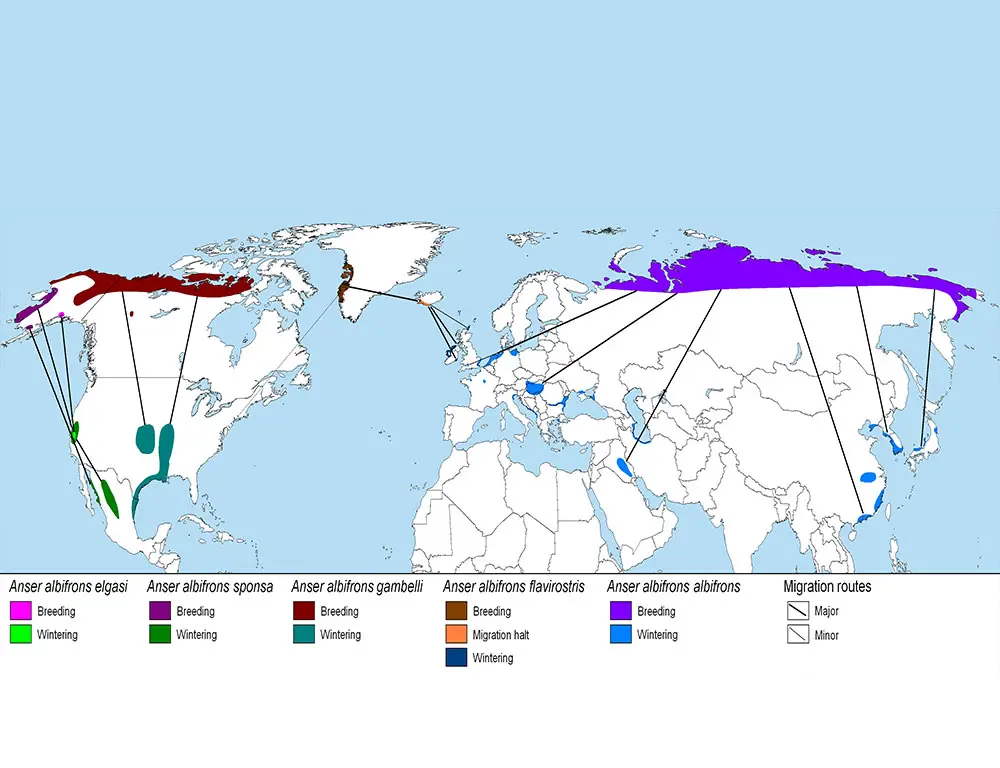
The Greater White-Fronted Goose has a vast range that spans across North America, Europe, and Asia. During the breeding season, it inhabits tundra and taiga regions of the Arctic and subarctic, including Alaska, Canada, Greenland, Scandinavia, and Russia.
In winter, it migrates south to temperate and subtropical regions, such as the United States, Mexico, Japan, and parts of Europe and Asia.
This highly adaptable species can be found in various wetland habitats, including marshes, lakes, rivers, and coastal estuaries. Here are some common diseases and treatments of this bird:
Avian Botulism
Avian botulism is a bacterial disease that affects waterfowl, including Greater White-Fronted Geese. It is caused by ingesting toxins produced by the bacterium Clostridium botulinum, which contaminates water bodies.
Treatment involves supportive care, including fluid therapy and nutrition, and administering antitoxin if available.
Aspergillosis
Aspergillosis is a fungal infection that can affect the respiratory system of birds, including geese. It is caused by inhaling spores of the fungus Aspergillus, which can increase in damp environments.
Treatment may involve antifungal medications administered orally or via nebulization and supportive care to improve respiratory function.
Lead Poisoning
Lead poisoning can occur in waterfowl like Greater White-Fronted Geese by ingesting lead-based ammunition or fishing tackle.
Lead toxicity can cause neurological and gastrointestinal symptoms and can be fatal if not treated promptly. Treatment typically involves chelation therapy to remove lead from the body and supportive care to manage symptoms.
Parasitic Infections
Geese may be susceptible to various parasitic infections, including internal parasites such as roundworms and tapeworms and external parasites like lice and mites. Treatment involves deworming medications for internal parasites and insecticidal treatments or bathing for external parasites.
Avian Influenza
Avian influenza is a viral disease that can affect waterfowl populations, including Greater White-Fronted Geese. Infected birds may experience respiratory symptoms, decreased appetite, and lethargy.
Treatment is limited, and affected birds may require supportive care to manage symptoms and prevent secondary infections.
Is the Greater White-Fronted Goose Endangered?
The Greater White-Fronted Goose is currently not considered endangered. It is classified as a species of “Least Concern” by the International Union for Conservation of Nature (IUCN).
While some populations may face localized threats from habitat loss, hunting pressure, and other human activities, the species maintains stable populations across its range.
Conservation efforts focused on habitat preservation, sustainable hunting practices, and monitoring of population trends are essential for ensuring the continued survival of this iconic waterfowl species.
6 Fun Facts About the Greater White-Fronted Goose
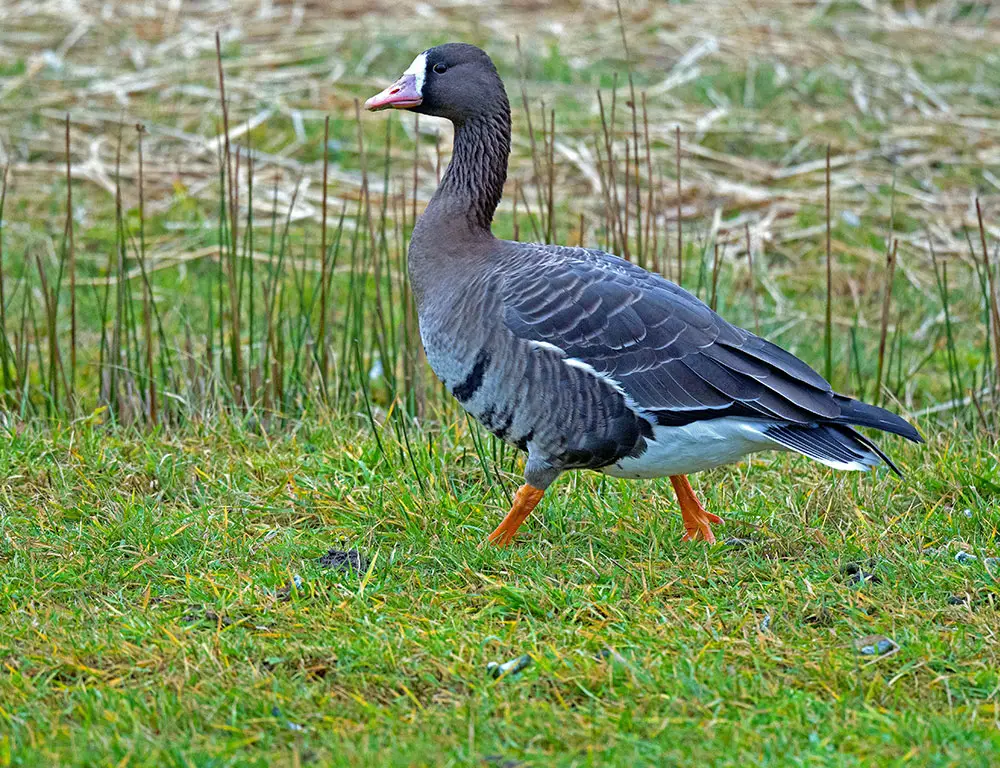
Delve into the fascinating world of the Greater White-Fronted Goose with these intriguing facts that showcase its unique characteristics and behaviors.
1. Distinctive Markings
The Greater White-Fronted Goose gets its name from the prominent white patch or “front” on its face, extending from the bill to the base of the throat. This distinctive marking sets it apart from other goose species.
2. Nomadic Nomads
These geese are known for their nomadic lifestyle, undertaking long-distance migrations between their breeding and wintering grounds. Their migrations can span thousands of kilometers, with birds traveling in large flocks along established flyways.
3. Family Affair
Greater White-Fronted Geese are typically monogamous and form strong pair bonds that last for multiple breeding seasons. Both parents share the responsibilities of nest construction, incubation, and caring for their young during the breeding season.
4. Vocal Performers
These geese are not just silent travelers. They produce a variety of calls, including honks, clucks, and yelps, which they use for communication, social bonding, and territory defense.
5. Grassland Grazers
While they primarily feed on plant matter such as grasses, sedges, and crops, Greater White-Fronted Geese may also consume insects and small invertebrates during the breeding season to supplement their diet.
6. Winter Wonders
In winter, Greater White-Fronted Geese gather in large flocks in their wintering grounds, forming impressive spectacles as they forage and roost together. These gatherings provide opportunities for socializing, mating, and strengthening social bonds among individuals.
FAQs
Where do Greater White-Fronted Geese migrate to?
Greater White-Fronted Geese undertake long-distance migrations between their breeding grounds in the Arctic and subarctic regions and their wintering grounds in temperate and subtropical areas.
They may travel thousands of kilometers along established flyways to reach their destination.
What do Greater White-Fronted Geese eat?
These geese primarily feed on plant matter, including grasses, sedges, and crops such as grains and tubers. During the breeding season, they may also consume insects and small invertebrates to supplement their diet.
How does Greater White-Fronted Geese communicate?
Greater White-Fronted Geese communicate through vocalizations, including honks, clucks, and yelps. These calls are used for communication within flocks, social bonding, territory defense, and mating displays.
Are Greater White-Fronted Geese monogamous?
Yes, Greater White-Fronted Geese are typically monogamous and form strong pair bonds that last for multiple breeding seasons. Breeding pairs work together to build nests, incubate eggs, and care for their young.
What is the typical lifespan of Greater White-Fronted Geese?
Greater White-Fronted Geese have a relatively long lifespan compared to other bird species, with individuals typically living for 10 to 15 years in the wild.
However, some individuals may live longer in optimal conditions, while others may have shorter lifespans due to predation, disease, or environmental factors.
Conclusion
The Greater White-Fronted Goose stands as a testament to the wonder and resilience of nature. Its seasonal migrations and habitat adaptations embody the spirit of endurance and adaptability in the face of changing environments.
As stewards of the natural world, we are responsible for protecting the habitats and ecosystems that the Greater White-Fronted Goose relies on for survival.
By conserving wetlands, grasslands, and other critical habitats, we can ensure that these magnificent birds continue to grace our skies for generations.
Let us celebrate the beauty and majesty of the Greater White-Fronted Goose and strive to create a future where wildlife thrives in harmony with the environment.
Together, we can safeguard the legacy of this remarkable species and preserve the rich tapestry of biodiversity that enriches our planet. Let’s enjoy the majestic features of this creature and maintain them.